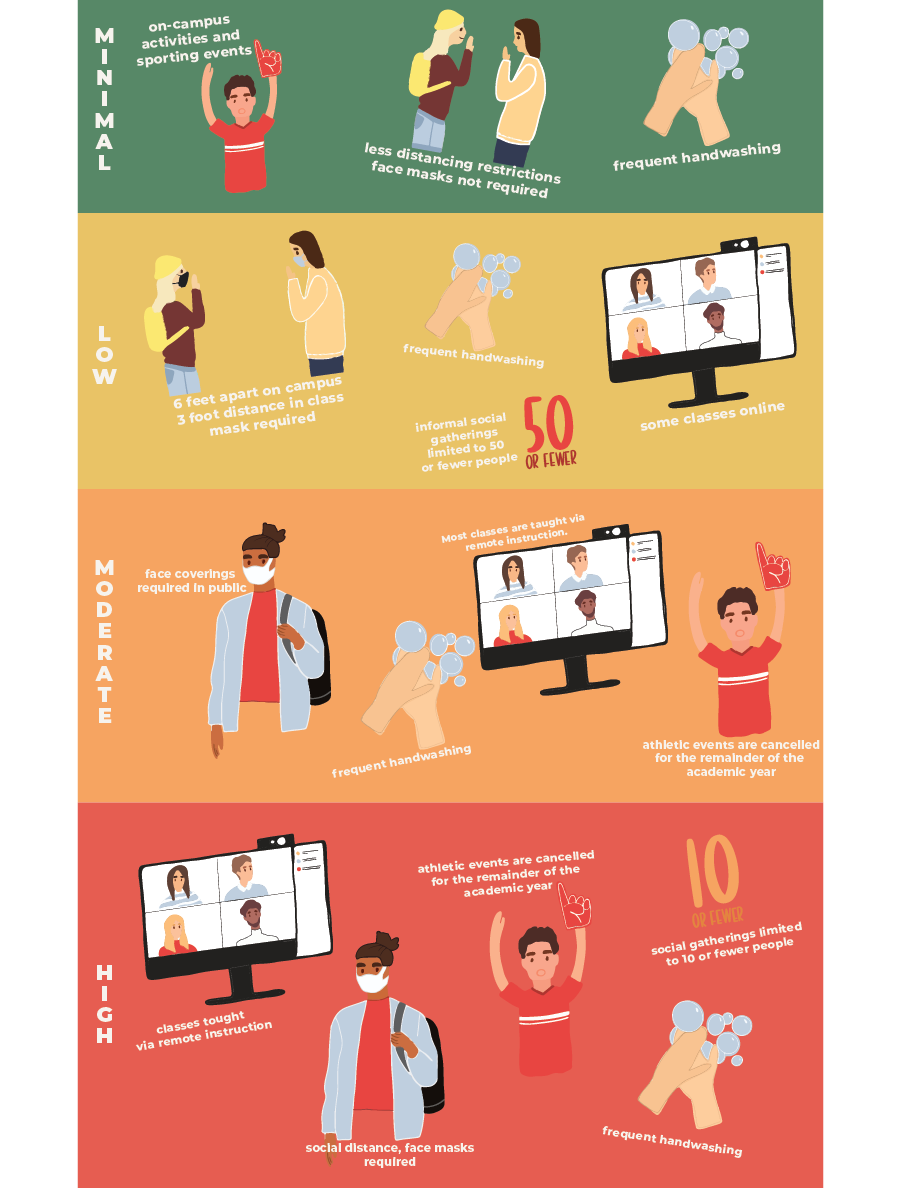
Dixie State University administration is basing its guidelines on what color zone the state remains in. DSU is currently following code "yellow." Graphic by Emily Wight.
To prioritize student, staff and faculty safety concerning COVID-19, Dixie State University is implementing new procedures and guidelines for the fall semester.
Instructional formats, face coverings, distancing requirements and janitorial procedures have all been adjusted to further curb the transmission of coronavirus on campus.
According to The Southwest Utah Public Health Department, Washington County is currently code “yellow,” or low risk/low restriction. The rate of spread, the number of new cases each day and the hospital capacity in the county and state are what determine each color-coded risk level.
If Washington County moves from yellow to orange (moderate risk) or red (high risk) before spring, all DSU classes will be moved online for the duration of the semester. If cases and hospital capacity get low enough that the county moves to green (minimal risk), distancing restrictions will be lessened, more classes will be held in person and on-campus activities and sports events will resume normally.
In accordance with the color code and the Centers for Disease Control and Prevention’s guidelines for low risk populations, everyone on the DSU campus is required to distance themselves 6 feet apart from one another and to keep a 3-foot distance while physically attending classes. Masks that cover both the mouth and nose must also be worn while indoors and during in-person classes.
The protocol for cleaning and maintaining campus facilities has also been adapted to better follow the CDC’s recommendations. Jack Freeman, director of facilities services, said the custodial staff is using a new equipment called electrostatic “foggers,” which spray a light mist of disinfectant that can kill the coronavirus in two to five minutes. This method is particularly useful for areas like auditoriums and arenas, but it will also be used if a student tests positive and is contact-traced to a specific classroom.
“Our practices and procedures were good to begin with; we just made adjustments to do more,” Freeman said. “The frequency of cleaning will be the same and increased in certain areas based on use and foot traffic.”
The Human Performance Center’s exercise equipment will be sanitized diligently after each use by custodial staff as well as the students who use the equipment.
Four key items will be in every classroom for student and faculty use: paper towels, spray sanitizer, disinfectant wipes and hand sanitizer. Custodial shift schedules have also been staggered to avoid overlap and to transition more workers from the graveyard shift to day shifts to accommodate the need for extra cleaning between classes.
“We’re doing everything that we possibly can so that contracting this COVID-19 is minimized, but we can’t control everything.”
Sociology professor Robert Oxley
Sherry Ruesch, assistant vice president of facilities management, said action was taken to sanitize everything as soon as possible after the shutdown in March.
“While everyone was gone, we almost immediately went in and really thoroughly cleaned all of the classrooms,” Ruesch said.
Ruesch stressed the lengths DSU has gone to in order to keep everyone on campus as safe as possible. Despite the setbacks in March, she’s confident the school is doing everything within its power and budget to ensure that things will run smoothly.
“I think it’s important to reassure the students that we’re doing more, cleaning more, that we know that they’re worried and that their parents are worried,” Ruesch said.
Cody Tolbert, a senior English major from Durant, Oklahoma, has reservations about the way DSU is proceeding.
“I think that there are some good ideas with the reopening plan, but I don’t think it’s going to last,” Tolbert said. “I feel like students and teachers will become complacent, so we will have to shut down again.”
Latest In News:
- DSU dance earns international accolades
- Current, former DSU employees previously employed at controversial troubled youth facilities
- Trailblazer Day of Giving was successful
Tolbert said he has no qualms with wearing a mask and feels that it’s similar to being cautious during flu season.
“I think that’s the best way to maintain safety through all this, but I know there’s an anti-mask movement going on, and I can foresee a lot of people just trying to ignore all of the precautions,” Tolbert said.
Sociology professor Robert Oxley said if a student attends class in person and refuses to wear a mask, the student will be asked to leave or the class will have to be canceled. Like Tolbert, he expects there to be a few “independent thinking” students that may argue against the mask mandate, but that there’s no wiggle room for negotiation.
“I’m cautiously optimistic about opening, but I am really nervous,” Oxley said. “The majority of the faculty and the administration and the staff are very nervous because of the uncertainty of this virus.”
Out of all the universities in Utah, DSU will have the most students on campus. The state average is about 30-35% on site, and DSU is estimated to have around 80%. Oxley said asymptomatic youth and incoming freshman “superheroes” who believe they are invincible to the virus are a definite cause for concern.
Oxley said: “We’re doing everything that we possibly can so that contracting this COVID-19 is minimized, but we can’t control everything. Once you’re done with your class, the parties on weekends… All it takes is one person to spread it, and there’s still no vaccine. On top of that, with influenza coming in the fall, I don’t know if we’ll make it all the way to the end of the semester.”
Want to read more? Follow us on Twitter and Facebook for daily articles and updates!
